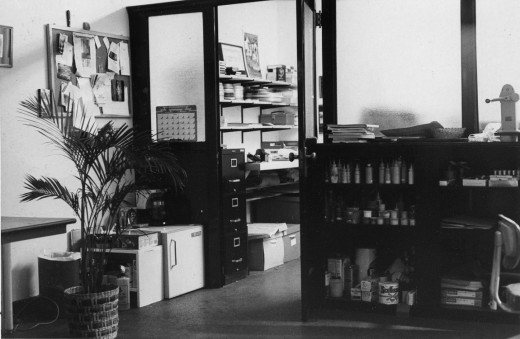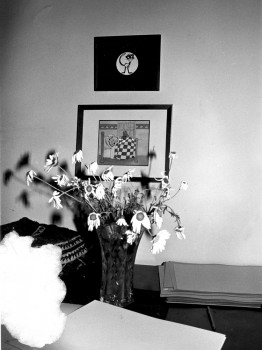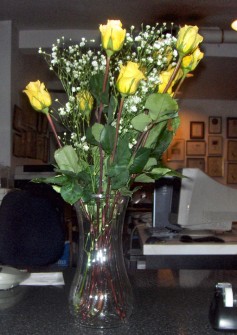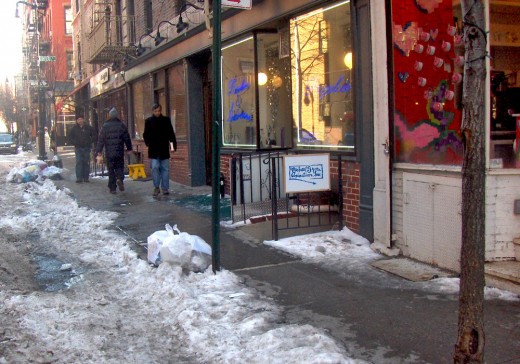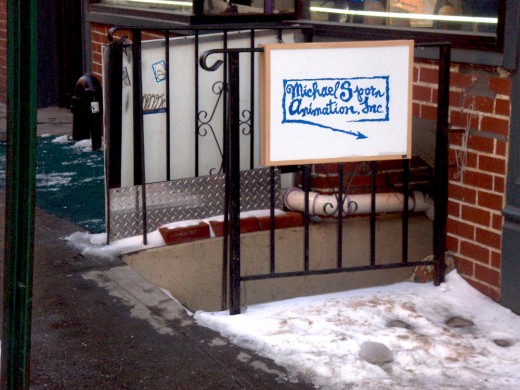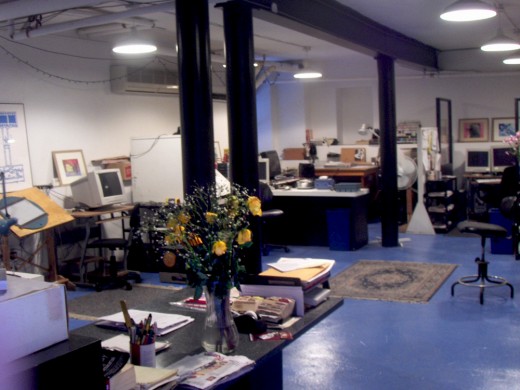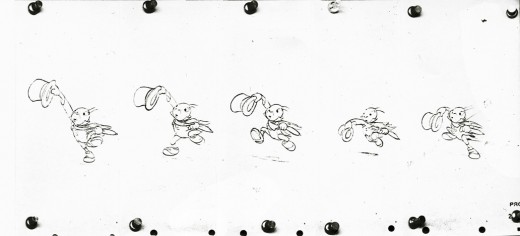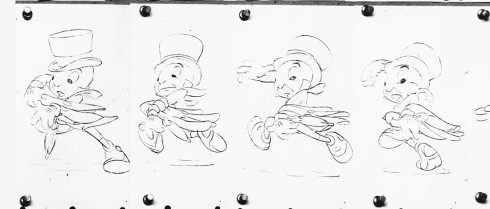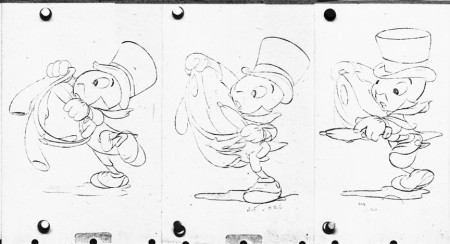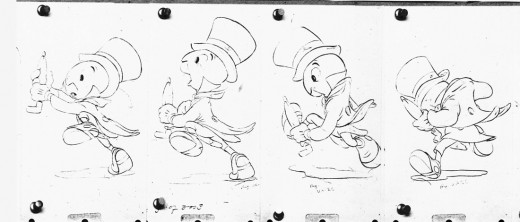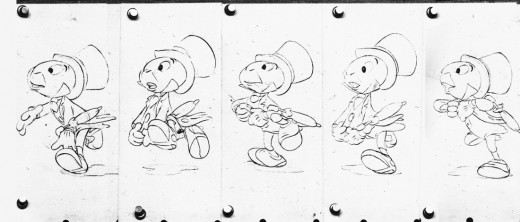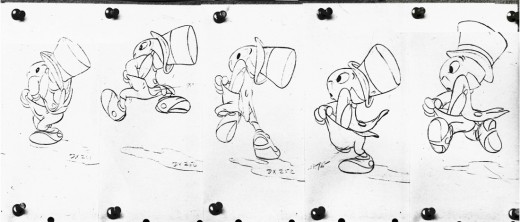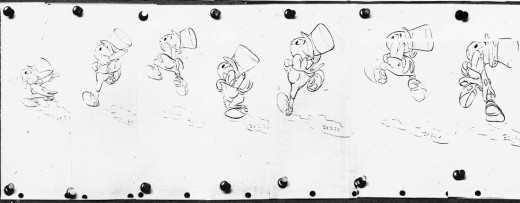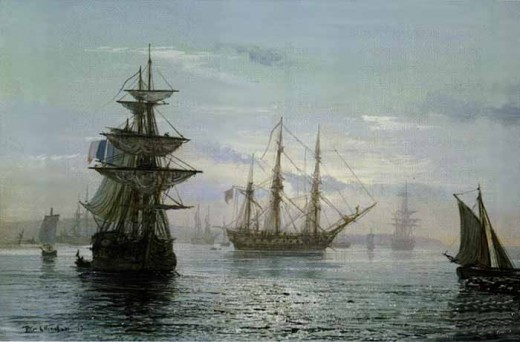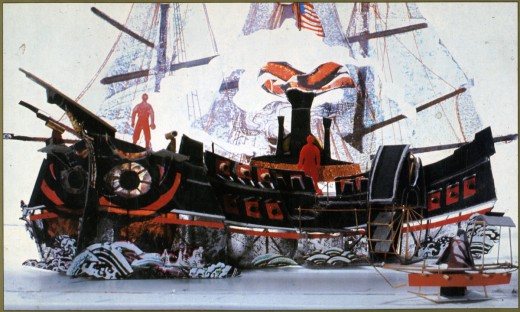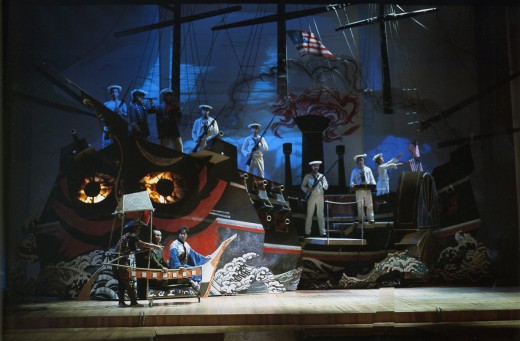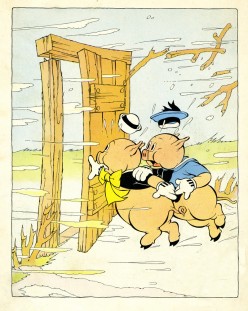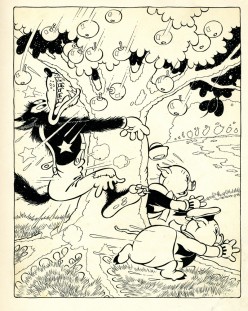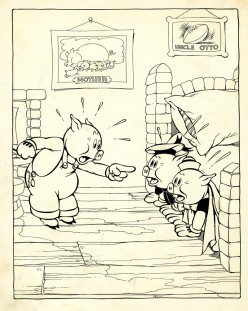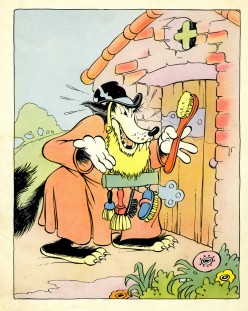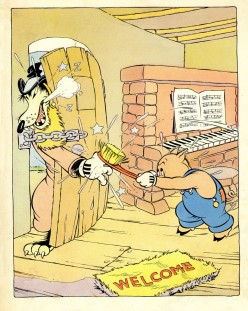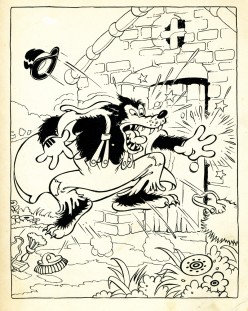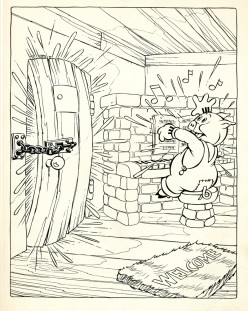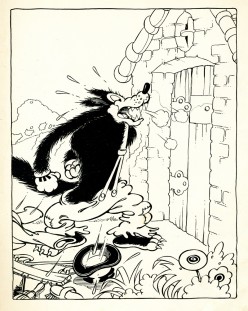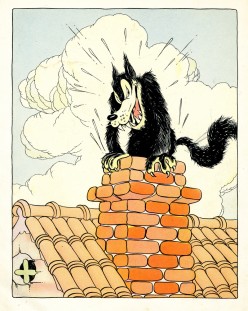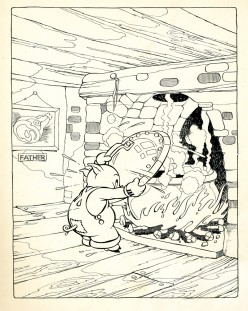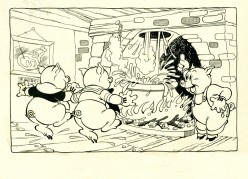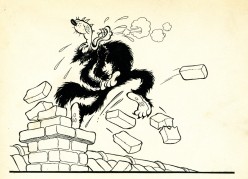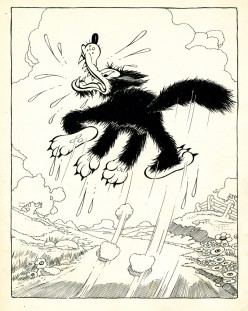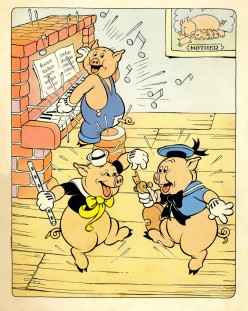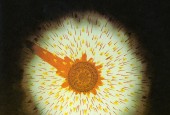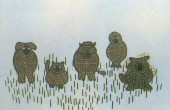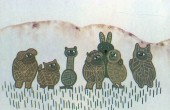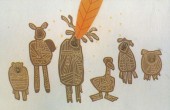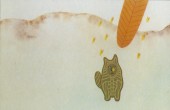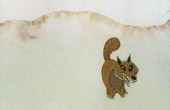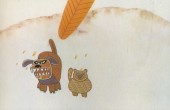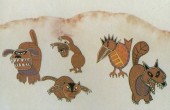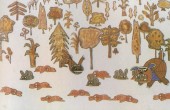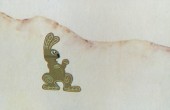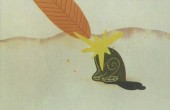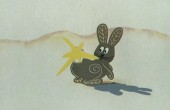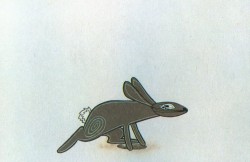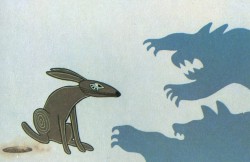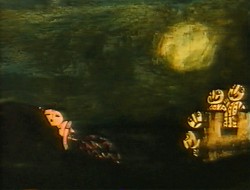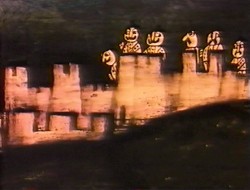Monthly ArchiveFebruary 2007
Photos 18 Feb 2007 10:18 am
Studio Studio Photo Sunday
- This Sunday’s photo features the only pictures I have of my very first studio. If you remember, from past wriitngs, originally I set up in an apartment leased by Richard Williams. I took care of his apartment while he was out of town (most of the time), and we did Woman of the Year out of that space. (You can see photos of that space here.) Once it became clear that I needed my own space, I found one in a building at One West 30th Street.
It was an historic building and a very interesting site. Every floor was decorated differently, and except for the second floor it was completely housing. The second floor had about half dozen office spaces. Two of them were Persian rug dealers with whom we spent time drinking a lot of Turkish coffee. (This area of NY features quite a few rug sellers.)
My office looked like something out of Sam Spade. All these steel and glass partitions broke the space up into two parts. In the photo above, I’m standing in the larger space (maybe 20 foot squared) which leads into the back area, my space. This was possibly 10×20. I loved it.
The B&W photo above left is the only other picture I have from that space. The framed cels are from Woman of the Year; it sits above the end title image from Morris’ Disappearing Bag. Both of these were done in 1981-82. Hence this photo dates back to 1982. The color image above was taken this morning from the vantage of our current studio’s front door. The flowers are on the front desk.
Last week we saw a day of heavy snow/rain/sleet which left the City covered with 3-4 inches of iced snow. A week later it still covers most of the town. Garbage is piling up a bit more than usual and construction has slowed down – just a bit.
This is the front of my building. A gypsy fortune teller sits just atop the entrace to my space – down a dozen steps. There’s a knitting shop (red for Valentine’s Day) next door. They have a cafe wherein many women seem to gather to knit. (I’ve only been in the store once, but it’s usually filled into the late hours.)
This is the actual entrace down some icy steps.
Once you go down these steps you have to walk down an icy, outdoor corridor. On the left you can see this corridor from the street side. On the right it’s from the studio side.
Finally. from the front door of this studio you see this space. (I’m literally standing in the doorway.) This room has four stations equipped with drawing tables and computers as well as two other computer setups. Paul Carrillo, my editor, works all the way in the back right. Matt Clinton, our principal animator on staff, works to the back left. Christine O’Neill, my assistant, sits behind the flowers, up-front.
My room is in another room to the right.
Daily post 17 Feb 2007 08:14 am
Hindemith & Bird & Oscars & Hans
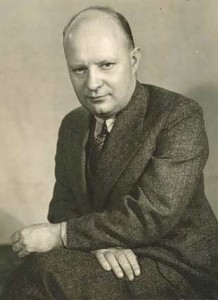 – Michael Barrier has an excellent essay on his site about Paul Hindemith‘s visit to the Disney Studio. The article was written by Don Draganski, and it’s a revealing piece of information. A letter by Hindemith discussing in depth his thoughts on Disney, Stokowski, and Fantasia which was in progress. Draganski, as Barrier informs us, is a composer in his own right.
– Michael Barrier has an excellent essay on his site about Paul Hindemith‘s visit to the Disney Studio. The article was written by Don Draganski, and it’s a revealing piece of information. A letter by Hindemith discussing in depth his thoughts on Disney, Stokowski, and Fantasia which was in progress. Draganski, as Barrier informs us, is a composer in his own right.
I once saw an exhilerating ballet by the Joyce Trisler Danscompany. Trisler was a student of Jerome Robbins who was brilliant in her own right. They performed a piece by Hindemith called “The Four Temperaments.” I fell in love with the music as much as the ballet. I tried in vain, at the time, to buy a recording of the piece, but there were none available. Trisler’s was a privately recorded copy. I saw the dance several more times falling more and more in love with it.
Paul Hindemith
As a youngish animator, I couldn’t help seeing the world through my own medium. I devised an idea to combine the ballet with animation which, like the music and the ballet, would be abstract. Just when I screwed up the courage to contact Trisler she died. She was young, and I was so upset at the lost talent that I had only so recently discovered. I did meet with someone from the company who represented them. They were eager to get involved. Eventually, however, the idea frittered away, and we never did it. This was years before computers would have made the plan an easy and relatively inexpensive one to execute. It was also a time when there was little money for the arts (Headline, NYDaily News: Ford to NY: Drop Dead) and raising funds for something with so little commercial value was not easy.
As an animation enthusiast and a fan of film scoring, I’ve always been intrigued by articles by musicians that talk of the world of music as it relates to animation. Ross Care is one composer (he scored my first short film, Byron Blackbear & the Scientific Method) who has written extensively about animation and has provided commentary tracks for animation dvds. Years ago, he arranged one of my favorite ASIFA-East programs. Alexander Steinert, officially the conductor on Bambi, came to analyze the score for that film and showed how the April Showers sequence developed musically.
Thanks to Mike Barrier for such an informative essay.
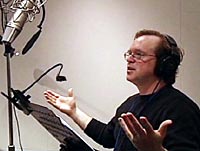 – There’s an excellent interview with Brad Bird at the Spline Doctors’ site. It’s nice to know how together this guy is; everything he articulates here is good for any young person in animation to hear – actually, it’s good for old people, too.
– There’s an excellent interview with Brad Bird at the Spline Doctors’ site. It’s nice to know how together this guy is; everything he articulates here is good for any young person in animation to hear – actually, it’s good for old people, too.
He has some thoughtful comments on the 2D vs 3D argument, on some of the Disney Masters, and it’s even interesing to hear how he pronounces the name of his new film – Ratatouille. (Not too surprisingly, this movie’s promotion comes with a pronunciation guide.)
Thanks to Mark Mayerson for leading me to the podcast.
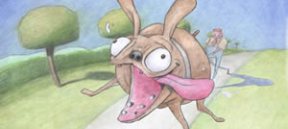 - The Oscar nominated shorts – Animated & Live Action – are being screened in the best possible way today at noon and 4PM at the Academy Lighthouse theater, 111 East 59th Street. It costs $5 general admission/ $2 with student ID.
- The Oscar nominated shorts – Animated & Live Action – are being screened in the best possible way today at noon and 4PM at the Academy Lighthouse theater, 111 East 59th Street. It costs $5 general admission/ $2 with student ID.
You can also see them at the IFC Center at 323 Sixth Avenue. Check their schedules. It also includes a couple of the shorts which were on the short list.
Joanna Quinn‘s short Dreams And Desires: Family Ties is not among those included nor is Dan Hertzfeldt‘s Everything Will Be OK.
Bill Plympton‘s shorts preceed all Live Action films at this theater. Good for him.
- In case you haven’t noticed, Hans Perk continues to post the Pinocchio drafts on his site A Film LA. What a resource this site is. I feel like I have my own little archive to go to. Thanks Hans.
Animation Artifacts 16 Feb 2007 07:49 am
Jiminy Crickets
Anyone know of any scenes animated recently that could compare with this one? Talk about loving the old days; my true colors are showing. This is a Milt Kahl scene Seq. 3 Sc. 26. (Thanks to Mark Mayerson and Hans Perk for this information.)
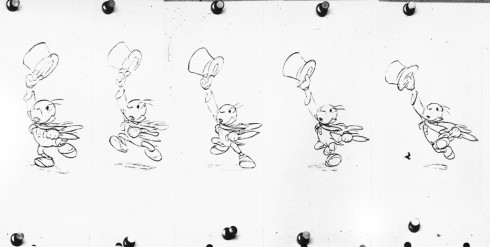
Notice how long that hat stays up there before he plops it on his head.
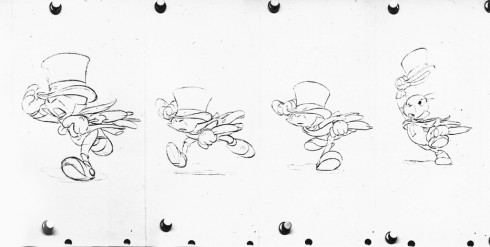
His head scrunches way down when the hat finally hits. The animation doesn’t pop in place as today’s animators would do (thinking they’re giving homage to Tex Avery, or maybe that’s all they know.)
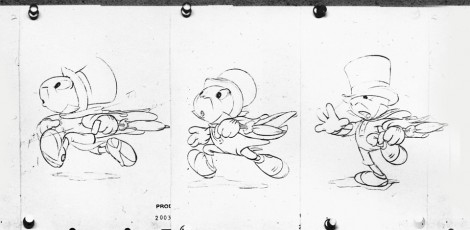
Something tells me the MoCap version of this scene wouldn’t work quite like this. I’m not completely convinced that even a cgi version would have such personality.
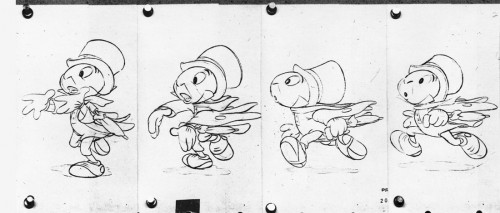
Notice how Jiminy’s hands come forward, calling attention to them in all the broad movement. This anticipates his next action which isn’t very large.
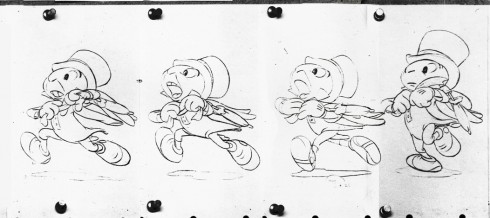
He fixes the tie. Loses it . . .
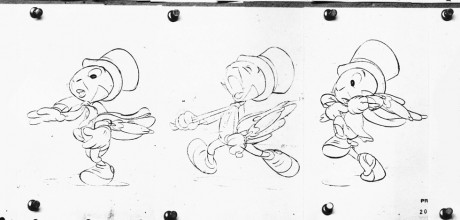
. . . and fixes it again. Good work.
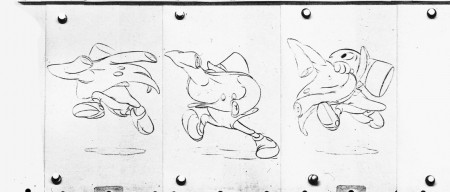
He uses the jump to fully get his coat on. Weight and gravity work for him here.
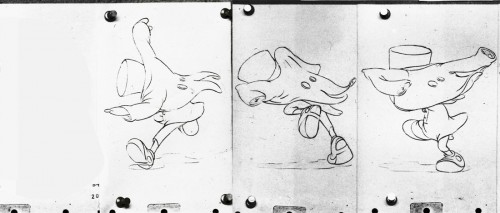
I love how he tries to push the umbrella throrugh the sleeve . . .
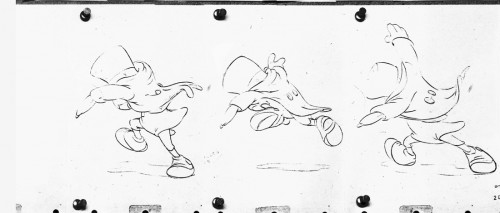
. . . and eventually pops it through.
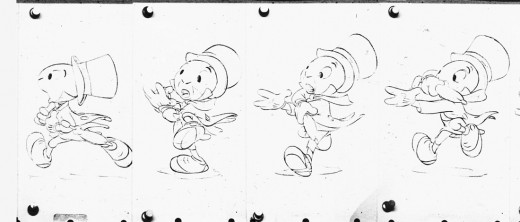
Finally, he puts the umbrella on his arm so as not to deal with it anymore.
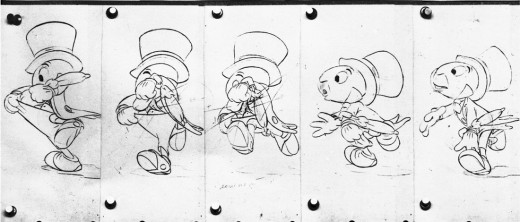
Almost a full stop to tuck in his pants.
This is a great scene; it uses an economy of drawing while developing character and still moving the film foreword. It goes beyond the drawings as all good animation does.
(Some of these drawings appeared as a flip book in the Thomas/Johnson book The Illusion of Life.)
Daily post &Fleischer 15 Feb 2007 08:24 am
Inkwells
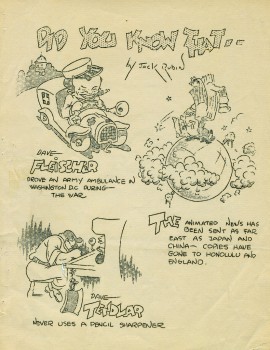 - G. Michael Dobbs has just posted the second chapter of his book on The Fleischer studio. It can be read on his site Made of Pen and Ink.
- G. Michael Dobbs has just posted the second chapter of his book on The Fleischer studio. It can be read on his site Made of Pen and Ink.
For those unfamiliar with this site, Dobbs has been writing this bio/animation history book for the last forever. He’s writing and posting it on the site one chapter at a time. Thus far we’ve had the prologue and chapters 1 & 2, and it’s already hot.
- In New York, there’s a lot of aniticipation for the Popeye dvd that’s scheduled to come out later this year. This is the one to be released by Warner Home Video/King Features and Hearst Entertainment. A lot of the animation community in New York were interviewed for an accompanying documentary for the disk. The doc is being directed by historian/film maker, Greg Ford, and should be pretty exciting.
(Click images to enlarge.)
Until then, there’s the Popeye’s Original Classics dvd which was released last year from Steve Stanchfield‘s Thunderbean Animation. As an added plus, if you buy this dvd you can hear the child version of me (1978) interviewing Jack Mercer about his Popeye Voice Overs. You can probably also use it to blackmail me.
This was originally a record that came with an issue of Mike Barrier‘s Funnyworld Magazine. it was supposed to be an incentive to buy the magazine, but I’m not so sure it worked. Regardless, I had a lot of fun doing it. I purposely chose Hal Seeger‘s studio, Channel Sound, to record the disk. That’s where they’d recorded a lot of the later Popeyes, and there were photos everywhere. Jackson Beck (Bluto) often stopped by to say hello. It’s also where I started out as a messenger going on asst. film editor.
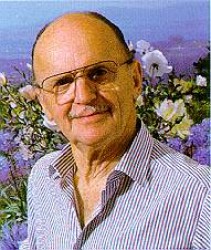 – Yesterday the news was all over the blogs about Peter Ellenshaw‘s death. Ellenshaw did all those wonderful glass matte shots in the Disney canon of live action films. The ships in Treasure Island wouldn’t have looked quite so beautiful if the surroundings weren’t Ellenshaw’s invention, and the rooftops of London – including that beautiful church steeple in the “Feed The Birds” sequence – of Mary Poppins wouldn’t have been so noble without his help. Nor the glens of Rob Roy, the town in Thomasina (my favorite Disney live action film), or the New England of Pollyana.
– Yesterday the news was all over the blogs about Peter Ellenshaw‘s death. Ellenshaw did all those wonderful glass matte shots in the Disney canon of live action films. The ships in Treasure Island wouldn’t have looked quite so beautiful if the surroundings weren’t Ellenshaw’s invention, and the rooftops of London – including that beautiful church steeple in the “Feed The Birds” sequence – of Mary Poppins wouldn’t have been so noble without his help. Nor the glens of Rob Roy, the town in Thomasina (my favorite Disney live action film), or the New England of Pollyana.
In 1979, the Museum of Modern Art had a show of Ellenshaw’s work with a lot of his matte paintings displayed, and he talked around a screening of shots he worked on from many of the films. I was struck with how impressionist the paintings were up close, yet on screen they looked so absolutely real. I asked about this, and he said that he found that the paintings had to feel a bit out of focus to achieve the effect of reality. When he painted in a very realistic mode, the paintings didn’t work.
The man knew what he was doing and was a master craftsman. Too bad that part of the film business seems to have died off. All effects now are “computer,” and I’m always so damned wistful for the past as I type this on my computer.
I’m sad to know he’s gone.
All this sniping going on between John Kricfalusi, Mike Barrier and Stephen Worth. Can’t we all just get along? It makes for entertaining reading, but it’s just getting too catty. Apparently the personalities don’t mix; I’m glad I’m not really involved. I notice the chat roooms are blistering with comments, but none of the sites seem to be discussing it.
Daily post 14 Feb 2007 07:52 am
Inspiration
- In these days of horrible animation, I find difficulty in getting inspired to do anything artistic. I want to work with more than a lackluster obeisance to duty. I need to feel excited about the work. So what I have to do is go searching. Fortunately, this has been going on for so long that I’ve found a couple of sure-fire sparks to do the job.
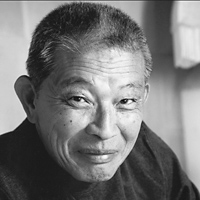 Today we were editing some documentary pieces which will accompany the two dvds I have coming out in May/June. The two will feature four half-hour shows I did of Andersen tales.
Today we were editing some documentary pieces which will accompany the two dvds I have coming out in May/June. The two will feature four half-hour shows I did of Andersen tales.
The Red Shoes/Little Match Girl on one.
The Emperor’s New Clothes/Nightingale on the second.
In talking with my editor, Paul Carrillo, I mentioned Mako‘s work as an actor and how I sought him to narrate the Nightingale back in 1992. (I set it in Japan rather than China, as in the original.) Mako, who died last year, was someone whose work I loved. He is best remembered, probably, for his role in The Sand Pebbles. Animation people probably are most familiar with his voice in Samurai Jack.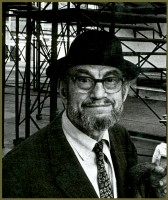
Back in 1976 I saw him in Pacific Overtures and was so impressed, I returned immediately to see the Sondheim musical a second time.
The beauty of this show, beyond Stephen Sondheim‘s music, was the amazing sets by Boris Aronson.
I went back to Frank Rich‘s book about his work.
I’ve talked about Aronson’s work before and probably will again. (First post here; second post here.)
Like Jiri Trnka’s artwork, Aronson’s designs inspire me beyond anything I see today. Boris Aronson
.
This guy gets my juices flowing. He was a true artist, and my respect for what he did in the theater inspires me beyond anything I can say here. There aren’t too many in designers in theater today who can compare. (Probably Bob Crowley and Tony Walton come close.)
Here are some of the setpieces that Aronson designed for Pacific Overtures on Browadway:
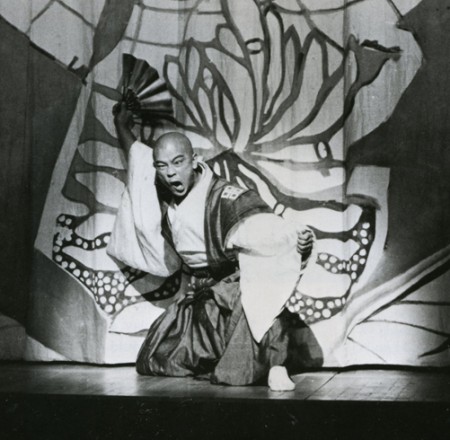
This is Mako within the show. He was the Reciter, the Shogun and the Emperor in it. He sang the opening lyrics I love so much; I only hear his voice and his intonations when thinking about this song:
In the middle of the sea.
The realities remain remote
In the middle of the sea.”
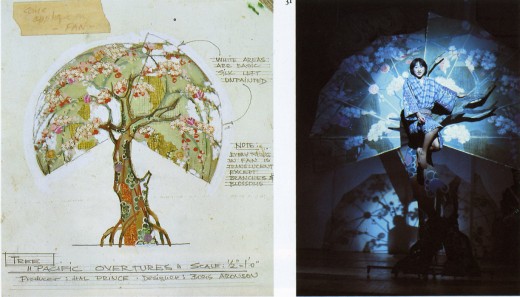
This is the design of the tree that blossomed like a Japanese fan. A young man climbed into it. An old man at the bottom of the tree represented the child grown up, and a third man lay under the treatyhouse where the Japanese negotiated with Admiral Perry. The house was designed so that the barbarian Americans would never have to touch Japanese soil, but would walk on tatami mats.
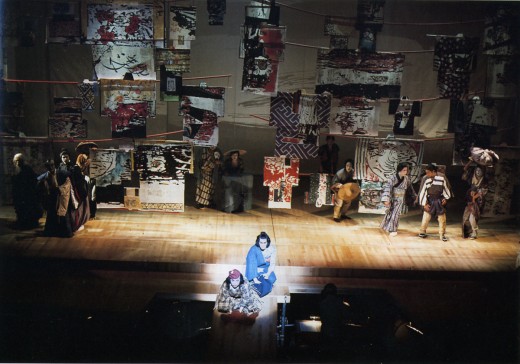
This is a setting wherein the soon-to-be minister will trek home with the sailor who has been “Americanized” in Boston.
Above is the design for the ship that morphed out of a dragon as it approached Japan.
The actual set is pictured below.
I wonder if Stephen Sondheim would allow an animated version of this show? He and I once discussed animating the show Assassins, but the book’s writer, John Weidman, wouldn’t allow an animated version. Sondheim seemed keen on the idea, and Hugh Wheeler wrote this book.
Animation Artifacts &Illustration 13 Feb 2007 08:03 am
Three Little Pigs Well Done
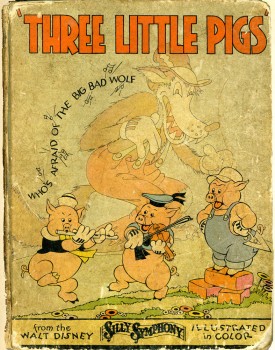 – Well, boys and girls, it’s time to complete our story. When last we left the three pigs, we saw that the wolf was huffing and puffing on the door of the 2nd little pig’s house where two of the little guys were hiding.
– Well, boys and girls, it’s time to complete our story. When last we left the three pigs, we saw that the wolf was huffing and puffing on the door of the 2nd little pig’s house where two of the little guys were hiding.
This is the completion of my posting of the book published in 1933 at the height of the Three Little Pig‘s phenomenonal success. The book’s illustrations have some of the charm of the original short
For years we heard that this was film acted as a metaphor for the Depression – the Big Bad Wolf knocking on America’s door. This supposedly was the reason for the film’s success. Was that an interpretation that was made during the Depression? I suppose if I were an historian I might actually look into it.
(Click on any image to enlarge.)
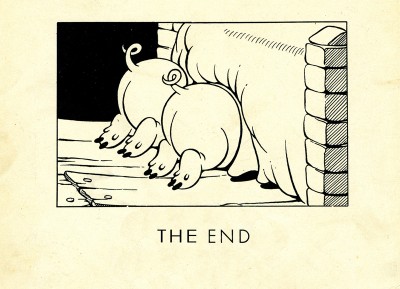
Daily post 12 Feb 2007 08:29 am
Last Blogging Week
- There has been a lot of good material, information and comment on other sites this past week. I’d like to highlight some of my favorite pieces, but first – the Award Shows.
- Congratulations to New Yorkers: Bill Plympton for winning the “Winsor McCay Award” at the Annies for “Recognition of lifetime or career contributions to the art of animation.”
Other kudos to Blue Sky for winning the Best Short film award for “Not Time For Nuts.”
- Last night, while everyone else was watching the Grammy’s, I was glued to my set to see the BAFTA awards. These are the British equivalent of the Oscars. Though their nominees were better or, in some cases, similar to the Oscars, their selections were as cockeyed and confused as the Oscars will be. They tried to give something to everyone and ended up not supporting anyone. See all nominees here.
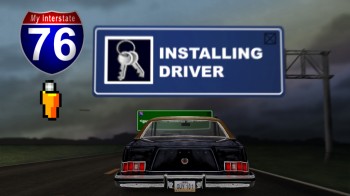 Certainly animation didn’t get support with their winners:
Certainly animation didn’t get support with their winners:
Happy Feet was the only MoCap film nominated in their awards. It won over Cars and Flushed Away (the closest they had to a Brit film).
Then the animated shorts saw strong injustice (in my humble opinion.)
Joanna Quinn‘s brilliant short Dreams & Desires: Family Ties – beautifully drawn and animated – was passed up for the winner. Ian Gouldstone‘s Guy 101 is a Royal College of Art film that has a compelling story about a gay seduction and bashing, and it’s basically a non-animated film. See it here.
If they wanted something compelling why not nominate and choose Rabbit by Run Wracke? At least there were drawings in that one.

Hans posts some Action Analysis notes from the Disney studios wherein instructor Don Graham leads a discussion of the use of rotoscope. It starts thus:
-
…that brings up a very good point – that there is just one reason why the rotoscope is used – and that’s because the men in the Studio can’t draw well enough. . . Problems come up every day that are really too difficult for the animator to execut at present.
As a result the rotoscope is used as a crutch.
Those lines alone are enough to understand why MoCap is so popular today. People who can’t animate or don’t want to learn or take the time to animate use Motion Capture. Live Action directors who want to be animators the easy way use MoCap.
Read this bit of historic conversation that nails the discussion perfectly. Go here to start. Continue here. An enormous thanks to Hans for posting this particular set of notes to put the exclamation point at the end of the conversation.
I have original copies of the complete Action Analysis lectures. The unfortunate part is that I don’t read them often enough. There’s so much information there that I need to start rereading.

Mike’s voice justifiably carries the weight of authority. For the most part – regarding the history of animation – his opinion is the correct one. He has done the work with hundreds of interviews, viewing of and evaluating most of the films and reading everything available. He has material to back up most of what he says.
His comments on February 8th took some of the “historians” to task for their sloppy writing – specifically regarding the notion that the Disney studio was built as a hospital in case it failed. (I may be wrong – I’ll have to look back, but I somehow remember that being stated in the Diane Disney Miller book as a way Walt had of defending the expense of the studio when he was giving his father a tour. Did anyone, at the time, ever say the statement was true?)
Mike’s anger seems equivalent to mine re the rudeness most people display on the streets of New York. Lots of bumping into and pushing aside everyone in the way. These days everyone has an air of self-importance and so few people merit it.
The blogs today are filled with folk claiming to boycott Mike’s books and blogs. Who cares? There aren’t enough animation readers and buyers to really make a difference.
Mike’s writing does make a difference, though. He takes pride in his history and has no patience for sloppiness. God bless him; his is one site I can and do trust.

- Another dependable site is Mark Mayerson‘s. Mark has become one of the foremost historians to read, and his site is invaluable in ways unique to his interests.
Take a look at his Sunday post. He revises and re-reviews his own analysis of Mickey’s Birthday Party.
To start with, his breakdowns of these classic Disney shorts (built from some of the drafts posted by Hans Perk) is invaluable. Mark takes the information, visualizes it and then returns with some in depth commentary which I usually find informative.
Yet he has the same passion for accuracy that Mike Barrier does. I love this site, and I love how all three of these sites overlap and comment on each other.
 – There are other sites I love and visit every day, but these three were the most effective for me last week. The big change at Cartoon Brew just happened today, so I’ll talk about that soon. But go check it out now.
– There are other sites I love and visit every day, but these three were the most effective for me last week. The big change at Cartoon Brew just happened today, so I’ll talk about that soon. But go check it out now.
Photos 11 Feb 2007 09:05 am
Photo Sunday – Heidi’s Birthday
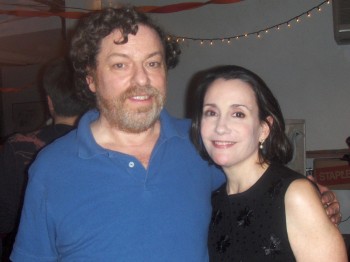 - This past Friday we celebrated Heidi’s birthday in my studio. It marked the first party in the newish studio. (Actually, we’ve already been here for three plus years. It’s hard to believe.)
- This past Friday we celebrated Heidi’s birthday in my studio. It marked the first party in the newish studio. (Actually, we’ve already been here for three plus years. It’s hard to believe.)
Some of my favorite people in the New York animation scene came out in the cold as well as a number of Heidi’s friends. I like posting the pictures here rather than on Flickr. It makes this blog a bit more personal.
(Click on any image to enlarge.)
Instead of gifts everyone was asked to bring a hand-drawn card. Easy for artists, but some of the most inventive and fun were from the non-artists. I may post a couple with Heidi’s permission in the next week.
The most amazing to me was a cel Tissa David gave her from a UPA short. It’s a beauty of a Taurean bull floating in the star filled sky. Its paper matte has printed on it “A UPA cel.”
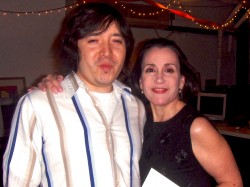 1
1 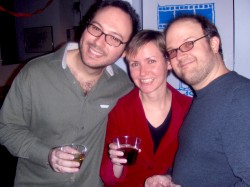 2
2
1. production coordinator/BG artist Adrian Urquidez (blowing a kiss to the camera) and Heidi.
2. ASIFA East Pres/animation Director Dave Levy and companion Debbie talk to designer/BG artist Jason McDonald.
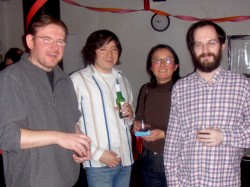 3
3 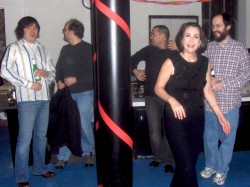 4
4
3. Dominik Spitol (Masako’s husband), Adrian Urquidez, animation producer Masako Kanayama, and animator Matt Clinton.
4. Adrian Urquidez, Jason McDonald, editor Paul Carillo, Heidi Stallings, and Matthew Clinton.
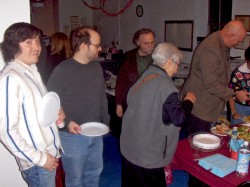 5
5 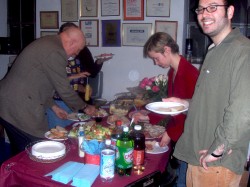 6
6
5. The food line (L to R): Adrian Urquidez, Jason McDonald, artist Ken Brown, Master Animator Tissa David, Chuck (Candy’s companion).
6. Chuck, animation director/producer Candy Kugel (partially hidden) Debbie, Dave Levy.
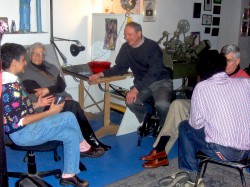 7
7 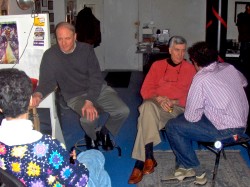 8
8
7. Candy Kugel, Tissa David, Joe Kennedy (John Canemaker’s companion), independent animator/author John Canemaker and animator John Dilworth.
8. Candy Kugel, Joe Kennedy, John Canemaker and John Dilworth
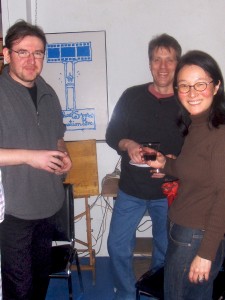 9
9 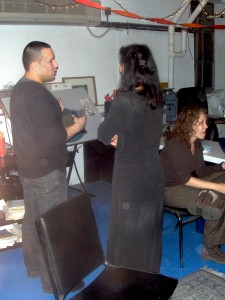 10
10
9. Dominick Spitol, artist Steve MacQuignon, Masako Kanayama.
10. Paul Carrillo, independent animator Lisa Crafts and actress Eileen Tepper
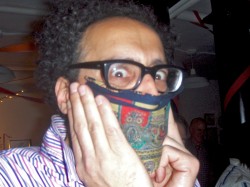 11
11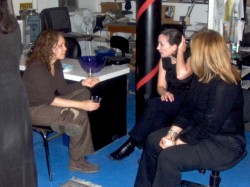 12
12
11. John Dilworth avoids the food by wearing a painted veil.
12. Eileen Tepper, Heidi and writer Jane Stouffer
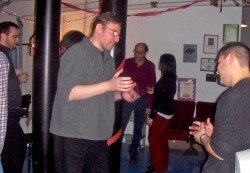 13
13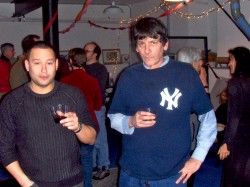 14
14
13. animator Ray Kosarin, Dominick Spitol, clay animator Jimmy Picker, Lorna (Paul’s companion) and Paul Carrillo.
14. Paul Carrillo and writer Jerry Rosco (my brother) stand in front. In back L to R:John Canemaker, Dave Levy (behind Paul), Debbie, Jason McDonald, Tissa David and Lisa Crafts.
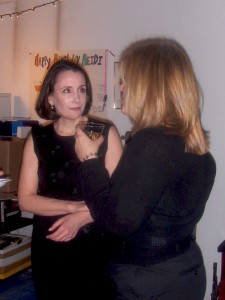 15
15 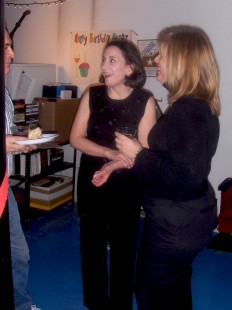 16
16
15. Heidi talking with friend Jane Stouffer
16. Actor Joel Briel (behind stanchion), Heidi and Jane.
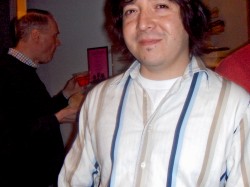 17
17 18
18
17. Joe Kennedy (in background) Adrian Urquidez (in foreground)
18. Steve MacQuignon (in background) Dave Levy (in foreground)
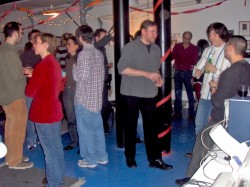 19
19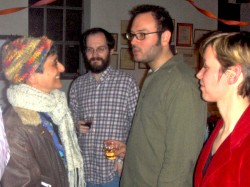 20
20
19. Dave, Steve MacQuignon (partially hidden), Debbie, Masako, Matt, animation director Ray Kosarin (arm over face) and Dominick
20. Candy, Matt, Dave and Debbie
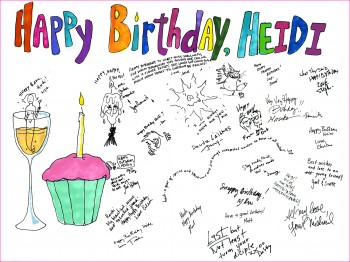

21. The card that everyone signed for Heidi. (Note that there are a number of others not photographed – such as Signe Bauman and Debby Solomon. Apologies to them, but I got lazy with the camera after a bit.)
22. The physical remains.
Animation Artifacts &Hubley 10 Feb 2007 08:44 am
Watership Down Down Down
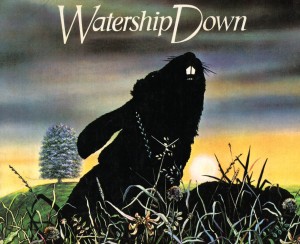 – Yesterday, Mike Barrier expressed some angerl on his site regarding sloppy animation history. He takes to task Stephen Worth and a couple of others.
– Yesterday, Mike Barrier expressed some angerl on his site regarding sloppy animation history. He takes to task Stephen Worth and a couple of others.
I couldn’t agree more with him regarding bad history on the internet. Errors appear everywhere, not just the internet but on these classic dvd’s we buy. (e.g: There’s conflicting information on #3 of the Looney Tunes set’s comment-ary tracks. It’s annoying. Since I particularly trust Barrier‘s accuracy, I went with his version.)
(Click any image to enlarge.)
I give you this information by way of introduction to some probably poor history I’ll present. Everything I offer is guess work. Unlike some others who are overconfident about their guess work, I’m emploring anyone who has conflicting information to let me know so that I can straighten the record and learn the truth, but I do feel somewhat confident.
The subject is John Hubley‘s involvment on the feature Watership Down.
I made some comments a couple of days back about Doonesbury and it prompted a question by David Nethery which started my rambling in response. I decided to add a couple of illustrations, and it’s evolved into this post.
There is no doubt in my mind that Hubley planned and shaped the opening sequence built around aboriginal art. Australian production designer, Luciana Arrighi often gets credit for this. However, I am sure Hubley put it into action and directed it. It’s his style. Perhaps it’s his style by way of Luciana Arrighi, but in the end it came out Hubley‘s.
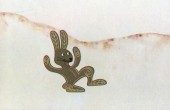
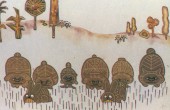
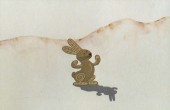
Also obviously his is the guiding spirit of the Black Rabbit of Inle which appears throughout the film particularly after the death of Hazel.
Bill Littlejohn, Phil Duncan, Ruth Kissane, and Barrie Nelson – all Hubley regulars – acted as animator or animation directors on the film. I think they visited the studio in England, but most certainly worked freelance from their homes. A guess – strictly a guess – is that Phil Duncan animated that opening. It feels like his work to me.
I was not in touch with John during this feature or after he had been pushed out of it. At the end of Everybody Rides The Carousel I moved over to Raggedy Ann. Dick Williams had been a hero of mine since the late sixties when I learned of his work. I’d had a number of letters back and forth to his Soho studio, and I contemplated the trip to show him my art. (How much easier everything is with the internet!)
As Carousel wound down, I watched closely as Dick competed for the Raggedy feature. He worked with Tissa David to do a short pencil test of Ann & Andy dancing to a piano score by Joe Raposo. Shamus Culhane was doing the same for Joe Oriolo. The two presentations went solidly Dick’s way, and he got that film. Tissa presented my name to Dick, and I was offered the first staff position on the upcoming feature.
At the same time, John Hubley was offered Watership Down. He had made the comment that he’d like to do the job that Halas & Batchelor had blown with Animal Farm, and he thought this could be the film fo that. This was a very exciting prospect to my ears. However John didn’t want me to go to England. I sure would have followed if he’d asked.
He asked if I would stay in New York and manage his studio there. He thought it might be possible to do some work in New York while he did the film in London. We even negotiated a very meager salary (John was the tightest guy I knew. He’d faced bankruptcy several times and watched his money closely.) Ultimately, watching what was about to happen half a mile away was too enticing for me. I wanted the chance to work with Dick Williams who had already brought on board Art Babbitt, Emery Hawkins, John Kimball, Gerry Chiniquy, Corny Cole and others. My allegiance was more with Tissa by this point, and I made my decision.
So, my analysis of the scenes I see is based solely on my love of Hubley’s work. I’ve inbetweened and inked and colored thousands of Phil Duncan’s drawings and scenes, and I’ve designed for John Hubley knowing full well that every drawing I was to do under him came out looking like a Hubley film. (John was the best artist I’ve ever met, so no one, in my opinion, could match what he could do with the simplest of lines.) I think my speculation on these short scenes in Watership Down is correct. I hope anyone won’t prove me wrong, but there it is.
There’s a very nice piece on the web by Richard Bell about his work in BG’s under Hubley and Martin Rosen.
There’s also an extensive and very insightful piece by Chris Boyce with analyzes the film in depth. He tries hard to separate what might be Hubley’s from Rosen’s.
Animation Artifacts &Luzzati & Gianini 09 Feb 2007 07:49 am
Luzzati & Gianini’s – An Italian In Algiers
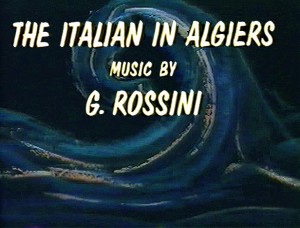 - An Italian In Algiers was one of the more popular films of Emanuele Luzzati and Giulio Gianini. The film was made in 1969 and was, like many of their other films, an adaptation of an opera using the overture as its soundtrack.
- An Italian In Algiers was one of the more popular films of Emanuele Luzzati and Giulio Gianini. The film was made in 1969 and was, like many of their other films, an adaptation of an opera using the overture as its soundtrack.
The opera’s story is about Isabella, an Italian woman, who is shipwrecked in Algiers and has become the apple of the eye of Mustafa, the bei of Algiers. Although he has a bevy of wives and slave women, he wants Isabella. Through cunning, she manages to escape Algiers with her young lover and a number of the slaves of Mustafa.
Essentially, the short film tells this same story – but without words.
Here, then, are a number of frame grabs. The film without the music.
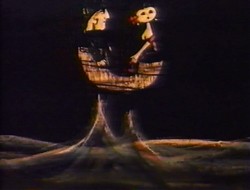
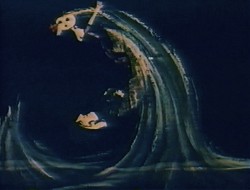
(Click any image to enlarge.)
Swept away by angry waves as they sail from Venice, newlyweds Lindoro and Isabella are washed ashore on the African coast.
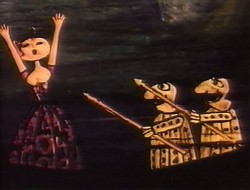
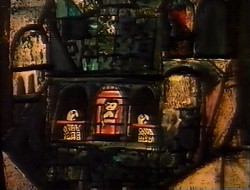
Isabella is captured and taken to a private space not too far from the other slaves and wives of . . .
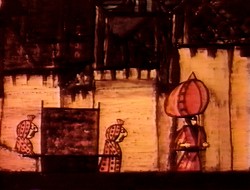
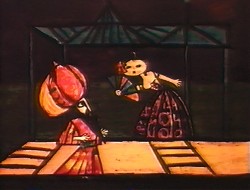
Mustapha visits Isabella, and she pretends to be interested.
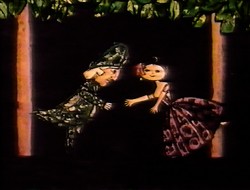
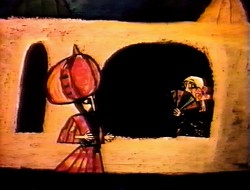
She is visited by her new husband, Lindoro. Mustapha learns of their visits.
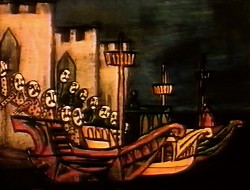
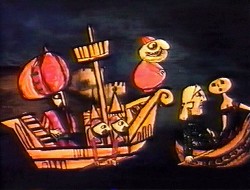
The film ends in a madcap sea chase with Isabella and Lindoro escaping as the curtain comes down.
